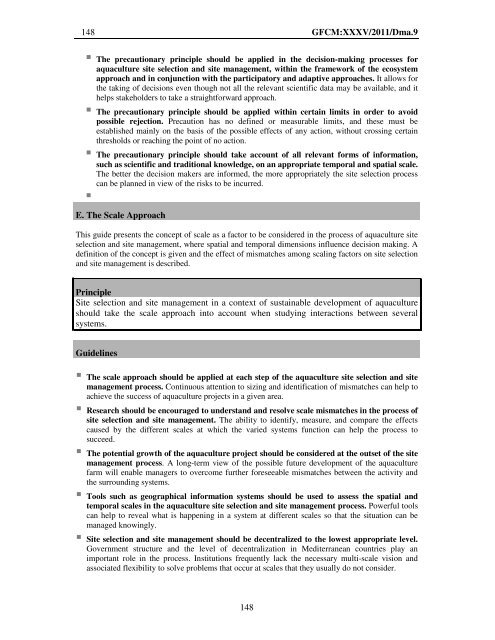Site selection and carrying capacity in Mediterranean ... - FAO Sipam
Site selection and carrying capacity in Mediterranean ... - FAO Sipam
Site selection and carrying capacity in Mediterranean ... - FAO Sipam
Create successful ePaper yourself
Turn your PDF publications into a flip-book with our unique Google optimized e-Paper software.
148 GFCM:XXXV/2011/Dma.9<br />
The precautionary pr<strong>in</strong>ciple should be applied <strong>in</strong> the decision-mak<strong>in</strong>g processes for<br />
aquaculture site <strong>selection</strong> <strong>and</strong> site management, with<strong>in</strong> the framework of the ecosystem<br />
approach <strong>and</strong> <strong>in</strong> conjunction with the participatory <strong>and</strong> adaptive approaches. It allows for<br />
the tak<strong>in</strong>g of decisions even though not all the relevant scientific data may be available, <strong>and</strong> it<br />
helps stakeholders to take a straightforward approach.<br />
The precautionary pr<strong>in</strong>ciple should be applied with<strong>in</strong> certa<strong>in</strong> limits <strong>in</strong> order to avoid<br />
possible rejection. Precaution has no def<strong>in</strong>ed or measurable limits, <strong>and</strong> these must be<br />
established ma<strong>in</strong>ly on the basis of the possible effects of any action, without cross<strong>in</strong>g certa<strong>in</strong><br />
thresholds or reach<strong>in</strong>g the po<strong>in</strong>t of no action.<br />
The precautionary pr<strong>in</strong>ciple should take account of all relevant forms of <strong>in</strong>formation,<br />
such as scientific <strong>and</strong> traditional knowledge, on an appropriate temporal <strong>and</strong> spatial scale.<br />
The better the decision makers are <strong>in</strong>formed, the more appropriately the site <strong>selection</strong> process<br />
can be planned <strong>in</strong> view of the risks to be <strong>in</strong>curred.<br />
<br />
E. The Scale Approach<br />
This guide presents the concept of scale as a factor to be considered <strong>in</strong> the process of aquaculture site<br />
<strong>selection</strong> <strong>and</strong> site management, where spatial <strong>and</strong> temporal dimensions <strong>in</strong>fluence decision mak<strong>in</strong>g. A<br />
def<strong>in</strong>ition of the concept is given <strong>and</strong> the effect of mismatches among scal<strong>in</strong>g factors on site <strong>selection</strong><br />
<strong>and</strong> site management is described.<br />
Pr<strong>in</strong>ciple<br />
<strong>Site</strong> <strong>selection</strong> <strong>and</strong> site management <strong>in</strong> a context of susta<strong>in</strong>able development of aquaculture<br />
should take the scale approach <strong>in</strong>to account when study<strong>in</strong>g <strong>in</strong>teractions between several<br />
systems.<br />
Guidel<strong>in</strong>es<br />
The scale approach should be applied at each step of the aquaculture site <strong>selection</strong> <strong>and</strong> site<br />
management process. Cont<strong>in</strong>uous attention to siz<strong>in</strong>g <strong>and</strong> identification of mismatches can help to<br />
achieve the success of aquaculture projects <strong>in</strong> a given area.<br />
Research should be encouraged to underst<strong>and</strong> <strong>and</strong> resolve scale mismatches <strong>in</strong> the process of<br />
site <strong>selection</strong> <strong>and</strong> site management. The ability to identify, measure, <strong>and</strong> compare the effects<br />
caused by the different scales at which the varied systems function can help the process to<br />
succeed.<br />
The potential growth of the aquaculture project should be considered at the outset of the site<br />
management process. A long-term view of the possible future development of the aquaculture<br />
farm will enable managers to overcome further foreseeable mismatches between the activity <strong>and</strong><br />
the surround<strong>in</strong>g systems.<br />
Tools such as geographical <strong>in</strong>formation systems should be used to assess the spatial <strong>and</strong><br />
temporal scales <strong>in</strong> the aquaculture site <strong>selection</strong> <strong>and</strong> site management process. Powerful tools<br />
can help to reveal what is happen<strong>in</strong>g <strong>in</strong> a system at different scales so that the situation can be<br />
managed know<strong>in</strong>gly.<br />
<strong>Site</strong> <strong>selection</strong> <strong>and</strong> site management should be decentralized to the lowest appropriate level.<br />
Government structure <strong>and</strong> the level of decentralization <strong>in</strong> <strong>Mediterranean</strong> countries play an<br />
important role <strong>in</strong> the process. Institutions frequently lack the necessary multi-scale vision <strong>and</strong><br />
associated flexibility to solve problems that occur at scales that they usually do not consider.<br />
148
















